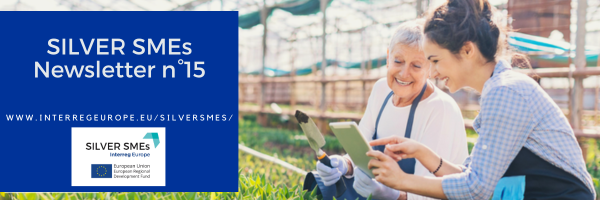
SILVER SMEs’ farewell newsletter is online!
SILVER SMEs is coming to an end, after 5 years of successful interregional cooperation. In our last newsletter you will find our results factsheet, available in
SILVER SMEs aims to improve the implementation and delivery of Regional Policies for SMEs competitiveness by building on significant opportunities arising from the Silver Economy (SE).
This 5 year Interreg Europe project was launched in June 2018.
€1,554,924.00
SME competitiveness
1. Silver SMEs objective
SILVER SMEs wishes to improve the implementation of Regional Policies for SMEs competitiveness by taking better advantage of opportunities derived from the Silver Economy.
Importantly, by supporting the development of new SMEs in the Silver Economy, an intrinsic objective is to generate services and goods that will contribute to improve the quality of life within an ageing society, in particular in rural or remote EU areas.
2. Silver SMEs expected impacts
Did you know that the Silver Economy accounted for over 78 million of jobs in the EU in 2015?
Through the development of the Silver Economy and support of SMEs in all stages of their life cycle, our project will bring important job opportunities in sectors of high relevance to the Silver Economy. Beside healthcare, the Silver Economy offers new opportunities as well for a wide range of subsectors, such as silver tourism, development of ICT Apps, Internet of Things, transport, shopping, cleaning, housing, etc.
We expect the project to identify relevant practices that will contribute to promoting the engagement of regions in innovation of Silver Economy SMEs. This will allow to develop, from a mid-term perspective, new ICT-products and services that will allow public authorities to deliver better and cheaper care for all.
To do so, we will change and improve 8 regional policies in our partners’ regions.
3. Silver SMEs main activities
Silver SMEs will identify and improve policy measures for the promotion of the Silver Economy. Our aim is for regional authorities to acknowledge the opportunities linked to the Silver Economy and develop tools for the business environment linked to the ageing society (62 years old onwards).
Silver SMEs will collect 60 good practices across the EU in the fields of housing, health, wellbeing, robotics, and ICT. Our approach will cover the SMEs development sectorial opportunities derived from key needs of 3 groups:
If you are interested in the project, have a look at the map of partners to see if you can be involved in the stakeholder groups or join us during the international policy workshops Silver SMEs will be organising on each of our key target groups, as well as a transversal seminar on “Senior Tourism & Accessibility”.
You can also find us on Facebook, Twitter and Linkedin.
The population of over 65 years old represents 21% of Aragon citizens. The index of ageing is of 114% in Aragon. Within the region of Aragon, the province of Teruel is getting more masculine and older, and, due to the lack of economic activities and jobs, it is losing around 10% of inhabitants each year.
Aragon’s Operational Programme has a special chapter for Teruel, focused on an Integrated Territorial Investment (ITI) at provincial level, that underlines the support at economic level to avoid “the negative effects of the depopulation”.
This document and ITI make a specific reference to the need of “improving the population structure in Aragon, with special attention to rural areas, focus on young and female population, and creating the conditions that allow moderating the excessive concentration of population, increasing the quality of services in rural areas guaranteed the access to education, health and social services”.
This strategy is more adapted to the reality of the region, but rather orientated towards public services. It should change and underline the importance of SME diversification to offer goods and services to elderly people.
Which partners are working on this? Provincial Government of Teruel
Dalarna has an old population, 30% is over 65 years old and the proportion of elderly over 75+ will considerably expand in 10-15 years. This poses challenges but also great opportunities for companies to develop services and products for a senior market that is not so well explored yet.
In Dalarna’s Agenda for smart specialisation two of the prioritized areas have a clear connection to the Silver Economy; Innovative experience production and health & welfare. We are developing an innovation system with clusters, societal actors and support from the research profiles in the Dalarna University College. The Operational programme for North Mid Sweden is an important tool in creating this, but the existing measures does not fully grasp the potential to promote actions through opportunities in the Silver Economy.
The Silver SMEs project affects directly to the priority axe number 3 which is related to two main investment priorities:
3a) To promote entrepreneurship, in particular by facilitating the economic exploitation of new ideas and fostering the creation of new firms, including through business incubators. Goal: To increase the number of enterprises with a growth potential.
3d) Supporting the capacity of small and medium sized enterprises to invest in the growth of regional, national and international markets and engage in innovation processes. Goal: Increased growth in the regions small and medium sized enterprises.
The silver project will contribute to fill the measures of the above policy instrument with a larger content from a focus on the opportunities for business development in the light of the demographic change; the ageing population in Europe.
As a result from Silver SMEs we want to see a higher number of innovative projects within the Silver economy in Dalarna the next programming period; 2021-2027.
The SME competitiveness and growth depends on innovation capacity, enabling SMEs to create new products and services, add value to the product, make the difference from the competition and gain control over the value chain. The diagnostic on the Northern Region of Portugal highlights innovation and technology transfer difficulties to market and low investment by SMEs in R & D & i .
In this sense, the objective of this Policy Instrument (PI) is to support the implementation within priority areas of smart specialization strategy the development of pilot projects, pre-commercial and commercial, to accelerate the introduction of new specialized services, with great knowledge, technologies and products on the market, increasing business investment in innovation, especially concerning the elderly people with specific needs and very demanding on quality, culture, kowledge, health, customized services.
The Silver Economy is a strategic subsector that is not mentioned in the PI so far, but that can bring plenty of opportunities for economic diversification, employment and growth, in line with the objectives of the PI. There is a clear need to improve the PI thus by including Silver Economy on the map, through specific references and innovative projects, especially to support new business projects that could create new products and services.
he specific objective of this priority is to increase employment levels in micro-enterprises in the S&E Region by supporting business start-ups, business expansion and higher innovation levels in micro-enterprises.
It will support innovative and growth oriented micro-enterprise business start-ups and expansions, with a particular emphasis on high-growth and potentially high-growth sectors through the provision of business information, advisory services, capability building, mentoring and financial supports.
Main Features: Linked to RIS3, opportunities for connected health and independent living technologies are technologies that facilitate remote delivery of healthcare and assisted living, moving the emphasis of care to the patient in their own home.
Objective: To harness for business the potential to transform healthcare and service delivery, thereby reducing burdens on health systems and improving the quality of life and independence of our ageing populations.
Reasons: The focus within the Silver SMEs project will be to implement effective mechanisms for industry engagement with the health system for exchange of ideas, trialling and developing new products and services by SMEs.
Why it should be improved: There are pressing demographic reasons due to an aging economy to develop more sustainable means of supporting independent living in older people. This presents a series of new opportunities for SMEs to engage in innovation directed at this sector.
OP for the Implementation of the EU Cohesion Policy in the Period 2014-2020; Priority axis 3. Dynamic and competitive entrepreneurship for green economic growth; Specific objective 3.2: Increase the added value of SMEs; 3.5 Social innovation, transnational cooperation and contribution to thematic objectives 1–7
Within the above-mentioned policy instrument document, there are no special actions regarding the development of Silver Economy (SE), but yes the specific objective 3.2 (Increase the added value of SMEs) within which it promotes the growth and development of SMEs in order to develop new and innovative products and services.
It also includes instruments of to enhance access to financial sources, such as: instruments of debt and equity financial sources, non-reimbursable financial sources for specific purposes and target groups, mentorship, business consulting.
The O.P. also supports contribution to broader social objectives, including social innovation, and sustainable development.
However and as mentioned, in O.P. ERDF 2014-2020 Slovenia there aren’t any specific measures on SE, while demographic trends of aging population is a clear opportunity for SMEs, start-up and especially for social enterprises to develop new products and services and for creation of new jobs.
New measures, concerning demographically endangered areas, should encourage directly SMEs, start-ups and social enterprises to contribute with innovative products to longevity of rapidly ageing population.
Castilla y León has among its distinguishing features being an eminently rural territory, with a large dispersion of population and aging.
According to official data (2016) the total population of Castilla y León is 2.447. 519 inhabitants. This represents a decrease in 60.977 inhabitants during the last 20 years (period 1996-2016). The current data of population aged over 65 years is 598.328 people, increasing the statistics of the year 1996 in 86.993 inhabitants.
On these grounds, Castilla y León is going through a major societal challenge in the form of a rapidly ageing population due to increased longevity combined with stagnating or falling birth rates in rural areas. An ageing society represents a number of opportunities for creation of jobs and growth that should be reflected in our strategies.
The Operational Programme ERDF 2014-2020 in the region of Castilla y León includes six different priority axes related to thematic objectives linked mainly to the smart and sustainable growth pillar of the Europe 2020 Strategy. The regional policy instrument is dealing with two investment priorities addressed by SILVER SMES project: “promotion of business spirit facilitating the economic exploitation of new ideas and inspiring the creation on new enterprises and the support to SMEs’ capacity to grow in regional, national and international markets as well as innovation processes” but not especially oriented neither rural areas nor silver economy.
Our activities are to support foreign companies willing to set up a business in Northern France and to support Northern France companies in their development, a large part belongs to the Silver Economy sector.
Indeed, with 1.3 million of seniors in 2012, Silver economy is today one the main strategical axis of development for 400 healthcare companies representing 8,000 jobs.
Consequently, Eurasanté will bring its experience in European projects and in supporting business projects devoted to the Silver Economy.
For example, we are working very closely with the Region on Silver economy sector.
Then, we created in September 2015 a call for proposal called “Silver Surfer” to develop innovations or technologies for the elderly people and to support silver economy SMEs.
And finally, we decided to launch in 2017 a special event on Silver economy called “AgeingFit” which is the 1st business convention at the European scale dedicated to innovation in the healthy ageing sector.“
The main objective of the programme is a long-term, intelligent and sustainable growth and increase in qualify of living of the inhabitants of Lubuskie Voivodeship through the use and strengthening the potential of the region and focus on combating development barriers.
The above goals include various TG, including persons above 50+, however, provisions concerning SME, acting for the benefit of these stakeholders, support require improvement (provision of services, production of goods). Possible for proposing solutions are, among others, support of entrepreneurs in the scope of internationalization, including both expansion of outlet markets and the possibility of international cooperation in the scope of knowledge exchange and gaining new experiences (i.e. OP 1 action 1.4 ROP). Furthermore, it is necessary to launch dedicated financial instruments for the above group of SME under OP 6. So far solutions support development of entrepreneurship, however, without taking into account the opportunities derived from the Silver Economy.
The region's policy is heading towards the support for actions towards the elderly persons. In order to fill the gap financial instruments supporting an increase of competitiveness of SME sector providing services and creating goods for healthy and active ageing would need to be created. In the region, the most difficult situation of these persons is noticeable within rural areas with limited nr. of SMEs provide services.

SILVER SMEs is coming to an end, after 5 years of successful interregional cooperation. In our last newsletter you will find our results factsheet, available in

SILVER SMEs is coming to an end, and it is time to take a look back at the project’s achievements, available at a glance in our results factsheet!

Today we meet with Vesna Kozar, Project Manager at the Soča Valley Development Centre, (Slovenia). She reports on how their Action Plan is boosting the Silver
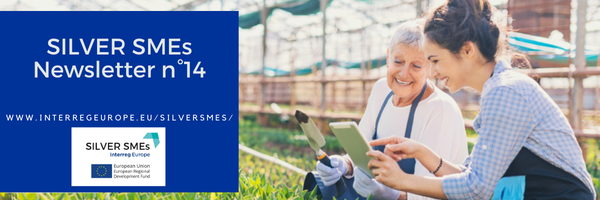
SILVER SMEs has made great progress in the last few months! We are still implementing our 8 Action Plans

Today we meet with Alice Charlet, Project Manager at Eurasanté in Lille (France). She reports on how the Action Plan developed by Eurasanté boosts the Silver

The rural Silver Economy is supported by European and regional policies as well as by local actions. This was the key message of the SILVER SMEs final conferenc

Today we meet with Dorota Bazuń, PhD at the Sociology Institute of the University of Zielona Góra. She tells us how the Action Plan for the Lubuskie region
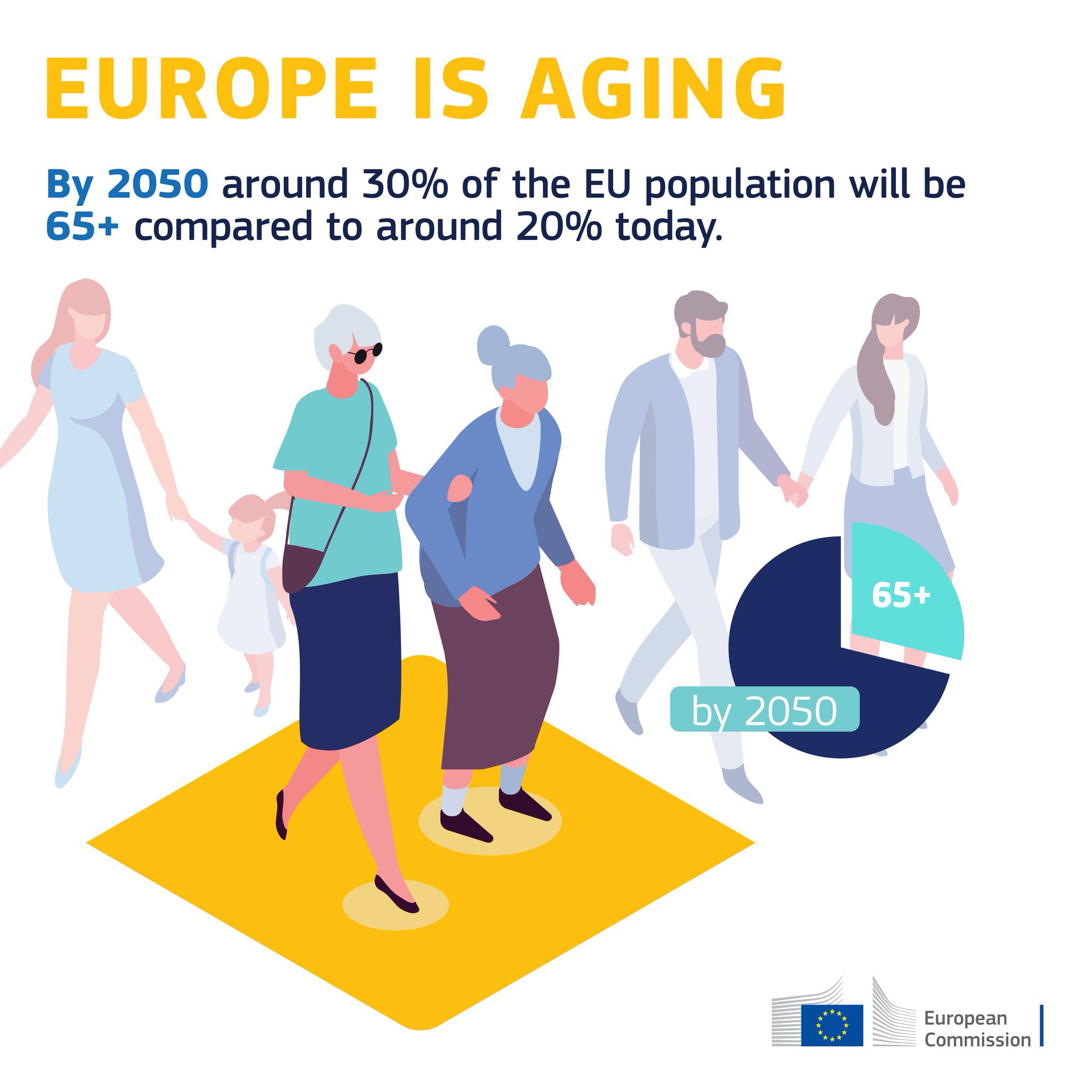
Rural Europe is ageing, but the Silver Economy can be part of the solution. This is the message shared by the European Commission in its “Report on the impact
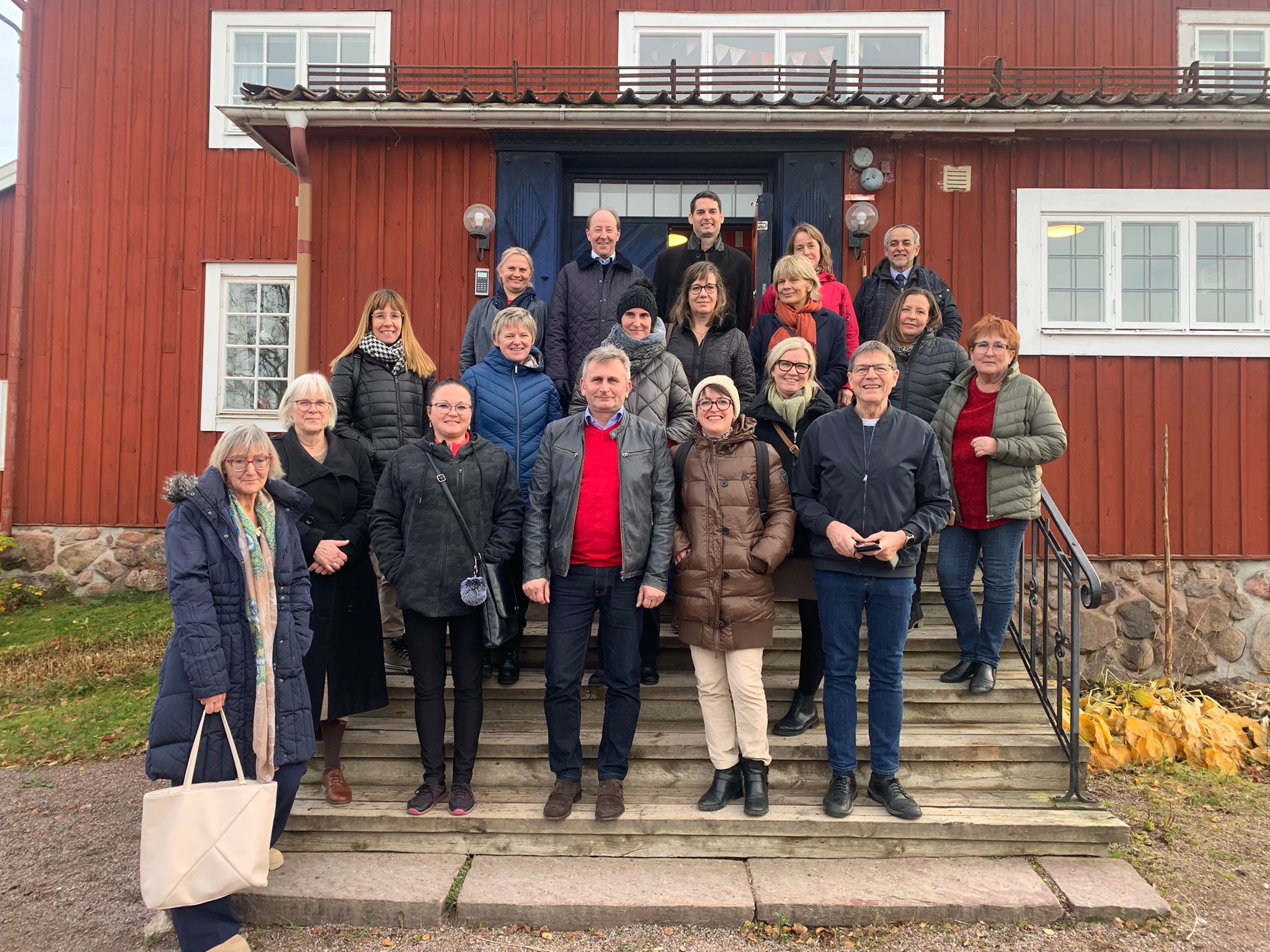
SILVER SMEs organised its 6th partners meeting on 19 and 20 October 2022 in Dalarna, Sweden. Organised and hosted by the Region Dalarna, the meeting was an
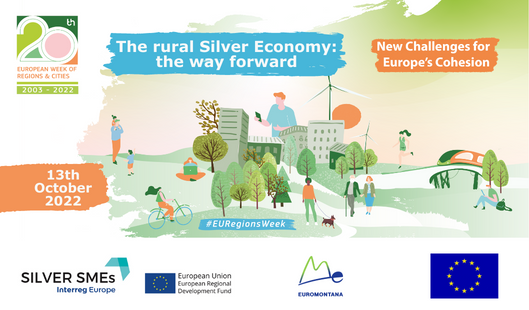
Last October, SILVER SMEs was present at the2022 edition of the European Week of Cities and Regions and organised an online project pitch session